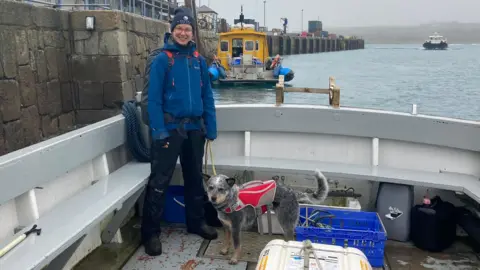Dog tasked with search for rats on Isles of Scilly
 Tessa Coledale
Tessa ColedaleA detection dog is being deployed to search for signs of rats on some of the Isles of Scilly.
Kuki and her handlers Laura Bambini, of the Royal Society for the Protection of Birds (RSPB), and Tessa Coledale, from Biosecurity for England, are due to check St Agnes, Gugh and Annet on 10 and 11 February to help keep the islands rodent-free.
In autumn the Isles of Scilly Wildlife Trust said it had conducted an "intensive incursion response" with the RSPB when probable signs of a mouse had been found on St Agnes.
Mice and rats were previously eradicated from the islands to help protect their nationally significant population of storm petrels.
Ms Coledale said detection was key and using dogs to help was "a new tool in our toolkit".
"Conservation detection dogs actively seek out their target smell, in Kuki's case - rat," she explained.
Need to act quickly
"They have a higher detection probability than passive techniques such as non-toxic wax chew blocks and can survey an area faster than conventional tools.
"They have up to 300 million scent receptors compared to our six million and they detect odours in parts per trillion - the equivalent of finding one dirty sock in a pile of two million clean ones!"
Ms Coledale said Kuki's findings would have to be acted on fast.
She explained: "If we do find an invasive predator on island we need to respond rapidly as one pregnant female rat can produce a colony of 300 individuals in just over eight months."
Permanent rodent surveillance devices - include non-toxic wax chew blocks, tracking tunnels and trail cameras - are regularly checked by the islands' residents and the trust, she added.
Follow BBC Cornwall on X, Facebook and Instagram. Send your story ideas to [email protected].
